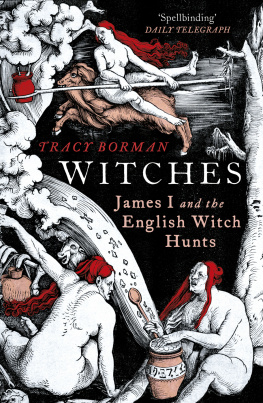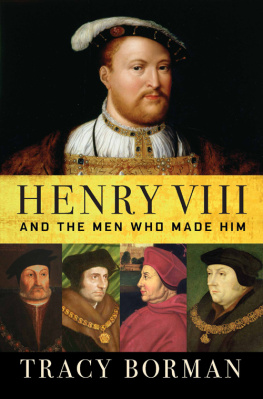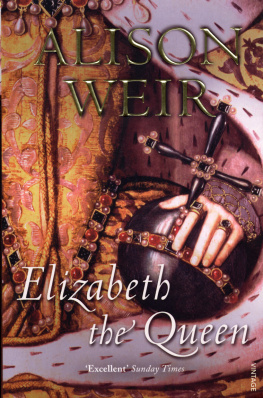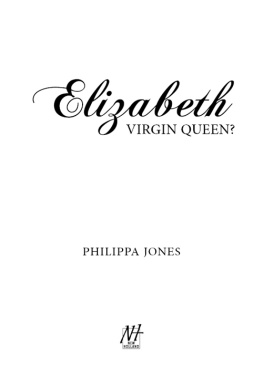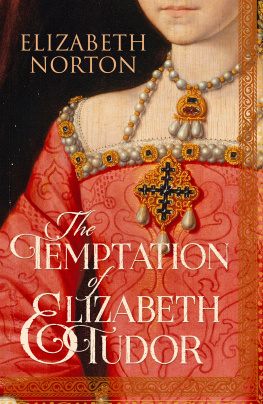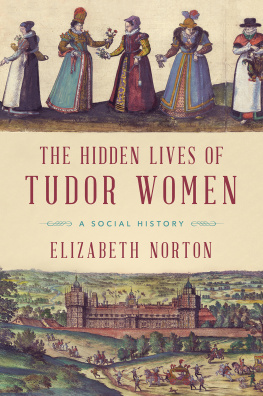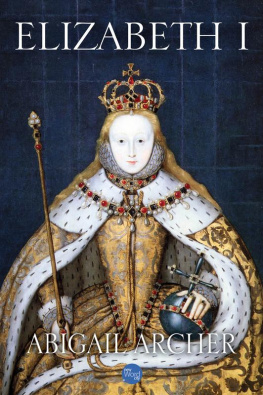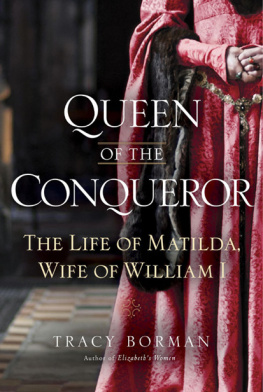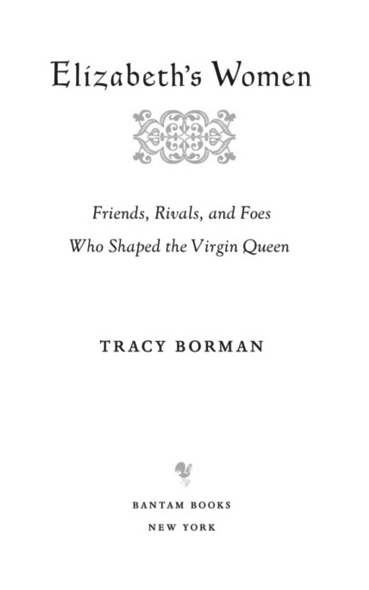ALSO BY TRACY BORMAN
Kings Mistress, Queens Servant:
The Life and Times of Henrietta Howard
Copyright 2009 by Tracy Borman
All rights reserved.
Published in the United States by Bantam Books, an imprint of The Random House Publishing Group, a division of Random House, Inc., New York.
B ANTAM B OOKS and the rooster colophon are registered trademarks of Random House, Inc.
Originally published in hardcover in Great Britain by Jonathan Cape, a division of The Random House Group Limited.
eISBN: 978-0-553-90786-5
www.bantamdell.com
Title-page illustration: Coronation portrait of Elizabeth I, modern reproduction of a lost original, by Peter Taylor.
v3.1

To my parents, John and Joan Borman,
with love and thanks for
all their support
Contents
Illustrations
SECTION 1
Elizabeth I when princess. By kind permission of the Royal Collection, 2009 Her Majesty Queen Elizabeth II.
Anne Boleyn by unknown artist. By kind permission of the National Portrait Gallery, London.
Locket ring belonging to Queen Elizabeth I, circa 1575. By kind permission of the Trustees of the Chequers Estate/Mark Fiennes/the Bridgeman Art Library.
Henry VIII and his children, with Will Somers, his court jester. By kind permission of the collection of the Trustees of the 9th Duke of Buccleuchs Chattels Fund.
Family of Henry VIII. By kind permission of the Royal Collection, 2009 Her Majesty Queen Elizabeth II.
Blanche Parrys memorial, Bacton Church, Herefordshire. By Tracy Borman.
Kat Astley. By kind permission of Lord Hastings.
Princess Mary at the age of twenty-eight, by Master John. By kind permission of the National Portrait Gallery, London, UK/the Bridgeman Art Library.
Jane Seymour, 1536 (oil on panel), by Holbein, Hans the Younger. By kind permission of Kunsthistorisches Museum, Vienna, Austria/the Bridgeman Art Library.
Portrait of Anne of Cleves (151557), by Holbein, Hans the Younger. By kind permission of the Louvre, Paris, France/Giraudon/the Bridgeman Art Library.
Katherine Howard. By kind permission of the Royal Collection, 2009 Her Majesty Queen Elizabeth II.
Portrait of Catherine Parr (151248). By kind permission of the National Portrait Gallery, London, UK/the Bridgeman Art Library.
Queen Mary I of England, by Mor, Anthonis, Isabella Stewart Gardner Museum, Boston, MA/the Bridgeman Art Library.
SECTION 2
Coronation portrait, modern reproduction of a lost original, by Peter Taylor.
La volta. By kind permission of Viscount De LIsle from his private collection at Penshurst Place.
Queen Elizabeth receives Dutch ambassadors, by Dutch School. Neue Galerie, Kassel, Germany/ Museumslandschaft Hessen Kassel/the Bridgeman Art Library.
Portrait miniature of Lady Katherine Seymour, ne Grey, by Teerlink, Lievine, Belvoir Castle, UK/the Bridgeman Art Library.
Lady Mary Grey (154578), by Eworth, Hans. By kind permission of the Trustees of the Chequers Estate/Mark Fiennes/the Bridgeman Art Library.
Mary, Queen of Scots. By kind permission of the collection of the Trustees of the 9th Duke of Buccleuchs Chattels Fund.
Lennox, by unknown artist. By kind permission of the National Portrait Gallery, London.
Elizabeth Talbot, Countess of Shrewsbury, by unknown artist. By kind permission of the National Portrait Gallery, London.
Lady Arabella Stuart, aged thirteen, by Rowland Lockey after English School, 1589, Hardwick Hall. By kind permission of the Devonshire Collection, NTPL/John Hammond.
Portrait of Elizabeth Fitzgerald, after Stephen van der Meulen (163290). By kind permission of Private Collection/the Stapleton Collection/the Bridgeman Art Library.
Lady Mary Dudley, Lady Sidney, circle of Hans Eworth. By kind permission of Petworth House, the Egremont Collection, NTPL/Derrick E. Witty.
A young lady aged twenty-one, possibly Helena Snakenborg, later Marchioness of Northampton, Tate, London 2009.
Elizabeth Knollys, attributed to George Gower, Montacute, the Sir Malcolm Stewart bequest (the National Trust), NTPL/Derrick E. Witty.
Elizabeth Vernon. By kind permission of the collection of the Trustees of the 9th Duke of Buccleuchs Chattels Fund.
Bess Throckmorton. By kind permission of the National Gallery of Ireland. Photo National Gallery of Ireland.
Queen Elizabeth in old age, English School/Corsham Court, Wiltshire/the Bridgeman Art Library.
Introduction
E lizabeth once famously declared: I know I have the body of a weak and feeble woman. This line, and the apparent regret with which she uttered it, has been taken to represent her conformity to the view that her sex was naturally subject to womanly weakness. Although she is often hailed as a shining beacon for womanhood, the embodiment of feminism before that term was even invented, Elizabeth was deeply conventional in her views of the female sex. When a foreign visitor to court complimented her upon her ability to speak many languages, she retorted that it was no marvel to teach a woman to talk; it were far harder to teach her to hold her tongue.
It is partly for this reason that Elizabeth is universally accepted as being a mans woman. As well as taking every opportunity to deride her sex, she loved to flirt with the many ambitious young men who frequented her court. Her liaison with Robert Dudley is well documented, as is her infatuation in old age with his stepson, the Earl of Essex, and her more sober relationships with trusted advisers such as Lord Burghley. Yet this tells only part of the story. Elizabeth deliberately showcased these relationships in order to carve out a place in what was essentially a mans world. In her own private world, the story was very different. Here it was the women, more than the men, who held sway.
Elizabeth was born into a world of women. No man had been admitted to the presence of her mother, Anne Boleyn, during her confinement at Greenwich Palace, childbirth being a strictly female mystery in the sixteenth century. As a child, she was served by a predominantly female household of attendants and governesses, interspersed with occasional visits from her mother and the wives who later took her place. As queen, Elizabeth was constantly attended by ladies of the bedchamber, maids of honor, and other members of her household. They clothed her, bathed her, and watched her while she ate. Among her family, it was her female relations who had the greatest influence: from her half sister, Mary, who distrusted and later imprisoned her, to her cousin Mary, Queen of Scots, who posed a constant and dangerous threat to her crown for almost thirty years.
Elizabeth met, corresponded with, and was influenced by hundreds if not thousands of women during the course of her long life. I have focused the story upon those women who help to reveal Elizabeth the woman, as well as Elizabeth the Queen. From her bewitching mother, Anne Boleyn, to her dangerously obsessive sister, Mary Tudor, and from the rivals to her throne such as the Grey sisters and Mary, Queen of Scots, to the flouting wenches like Lettice Knollys, who stole her closest male favorite, these were the women who shaped the Virgin Queen, and it is through their eyes that the real Elizabeth, stripped of her carefully cultivated image, is revealed.


